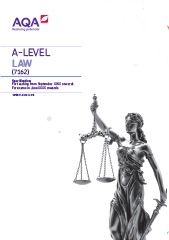3.2 Criminal law
Content |
Additional information |
|---|---|
The rules of criminal law |
Rules and principles concerning general elements of criminal liability and liability for offences against the person, property offences and attempt. |
Theory in criminal law |
Harm as the basis for criminalising conduct. Autonomy, fault and individual responsibility. Principles in formulating rules of criminal law:
|
General elements of liability |
Actus reus:
Additional fault elements:
No fault: strict liability. Coincidence of actus reus and mens rea. |
Fatal offences against the person |
Common law offence of murder: voluntary manslaughter:
Common law offence of involuntary manslaughter:
|
Non-fatal offences against the person |
Common assault:
Offences Against the Person Act 1861:
|
Property offences |
Theft (s1 Theft Act 1968). Robbery (s8 Theft Act 1968). |
Preliminary offence |
Attempt (s1 Criminal Attempts Act 1981). |
Defences Capacity defences |
|
Defences Necessity defences |
|
